

PARP: Animowana "Historia Polski". Poland Travel Notes. Short URL: - National Anthem of Poland.
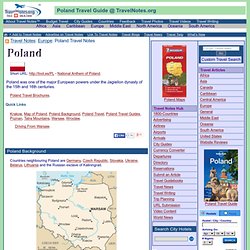
Poland. Poland i/ˈpoʊlənd/ (Polish: Polska), officially the Republic of Poland (Polish: Rzeczpospolita Polska), is a country in Central Europe, bordered by Germany to the west; the Czech Republic and Slovakia to the south; Ukraine, Belarus to the east; and the Baltic Sea and Kaliningrad Oblast (a Russian exclave) and Lithuania to the north.
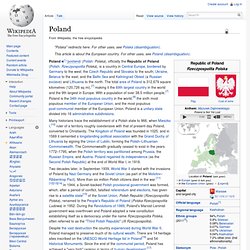
The total area of Poland is 312,679 square kilometres (120,726 sq mi),[7] making it the 69th largest country in the world and the 9th largest in Europe. With a population of over 38.5 million people,[7] Poland is the 34th most populous country in the world,[9] the sixth most populous member of the European Union, and the most populous post-communist member of the European Union. Poland is a unitary state divided into 16 administrative subdivisions. Greater Poland. The proper Greater Poland Greater Poland, often known by its Polish name Wielkopolska [vjɛlkɔˈpɔlska] ( ) (German: Großpolen; Latin: Polonia Maior) is a historical region of west-central Poland.
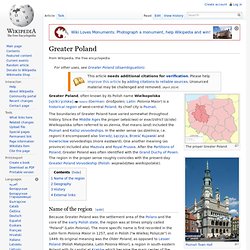
Its chief city is Poznań. The boundaries of Greater Poland have varied somewhat throughout history. Since the Middle Ages the proper (właściwa) or exact/strict (ścisła) Wielkopolska (often referred to as ziemia, that means land) included the Poznań and Kalisz voivodeships. Lesser Poland. Lesser Poland (in the basic meaning) Lesser Poland (Polish Małopolska, Latin Polonia Minor) is a historical region (dzielnica) of Poland; its capital is the city Kraków.
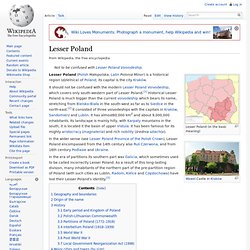
In the wider sense (see Lesser Poland Province of the Polish Crown), Lesser Poland encompassed from the 14th century also Ruś Czerwona, and from 16th century Podlasie and Ukraine. Piast dynasty. Mieszko I of Poland. Mieszko I (

Kingdom of Poland (1025–1385) Bolesław I Chrobry. Bolesław I Chrobry (Bolesław I the Valiant, or the Brave; Czech: Boleslav Chrabrý; Polish ; 967 – 17 June 1025; previously also known as Bolesław I the Great, "Wielki"), was a Duke of Poland during 992–1025 and the first crowned King of Poland since 18 April 1025 until his death two months later.
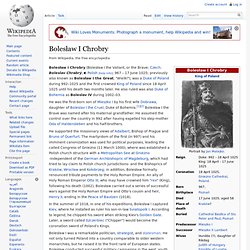
He also ruled was also Duke of Bohemia as Boleslav IV during 1002–03. He was the first-born son of Mieszko I by his first wife Dobrawa, daughter of Boleslav I the Cruel, Duke of Bohemia.[1][2] Bolesław I the Brave was named after his maternal grandfather. He assumed the control over the country in 992 after having expelled his step-mother Oda of Haldensleben and his half-brothers. Oda of Haldensleben. Oda of Haldensleben (ca. 955/60 – 1023) was a German noblewoman and by marriage Duchess of the Polans.
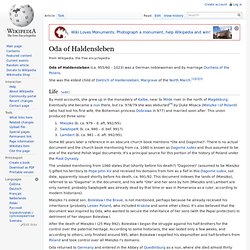
She was the eldest child of Dietrich of Haldensleben, Margrave of the North March.[1][2][3] Life[edit] By most accounts, she grew up in the monastery of Kalbe, near to Milde river in the north of Magdeburg. Eventually she became a nun there, but ca. 978/79 she was abducted[4] by Duke Misaca (Mieszko I of Poland) (who had lost his first wife, the Bohemian princess Dobrawa in 977) and married soon after. This union produced three sons: Mieszko (b. ca. 979 – d. aft. 992/95).Świętopełk (b. ca. 980 – d. bef. 991?). Some 80 years later a reference in an obscure church book mentions "Ote and Dago(me)".
The undated mentioning from 1080 states that (shortly before his death?) Mieszko I's oldest son, Bolesław I the Brave, is not mentioned, perhaps because he already received his inheritance (probably Lesser Poland, who included Kraków and some other cities). Sources[edit] Schwennicke, Detlev. Bolesław II the Generous. Bolesław II the Generous, also known as the Bold and the Cruel (Polish: Bolesław II Szczodry Bolesław II is considered to have been one of the most capable of the Piast rulers.

In 1075 he re–established the Archdiocese of Gniezno (consecrated in 1064) and founded the Diocese of Płock. He established Benedictine monasteries in Mogilno, Lubin and Wrocław. Roman Catholic Archdiocese of Gniezno. The Archdiocese of Gniezno (Latin: Gnesnen(sis)) is an archdiocese located in the city of Gniezno in Poland.
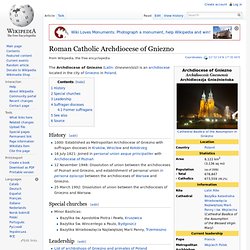
History[edit] 1000: Established as Metropolitan Archdiocese of Gniezno with suffragan dioceses in Kraków, Wrocław and Kołobrzeg16 July 1821: Joined in personal union aeque principaliter with Archdiocese of Poznań12 November 1948: Dissolution of union between the archdioceses of Poznań and Gniezno, and establishment of personal union in persona episcopi between the archdioceses of Warsaw and Gniezno.25 March 1992: Dissolution of union between the archdioceses of Gniezno and Warsaw. Special churches[edit] Minor Basilicas: Bazylika św. Apostołów Piotra i Pawła, KruszwicaBazylika Św. Leadership[edit] Bolesław III Wrymouth.
Poland during the rule of Bolesław III Wrymouth Bolesław III Wrymouth (also known as Bolesław III the Wry-mouthed, Polish: Bolesław III Krzywousty) (20 August 1086[1][2] – 28 October 1138), was a Prince of Lesser Poland, Silesia and Sandomierz during 1102-1107 and over all Poland during 1107-1138.
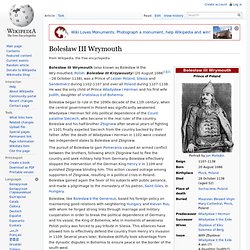
Encyclopedia Britannica. The dual Polish-Lithuanian state, Respublica, or “Commonwealth” (Polish: Rzeczpospolita), was one of the largest states in Europe. While Poland in the mid-16th century occupied an area of about 100,000 square miles (260,000 square km), with some 3.5 million inhabitants, the Commonwealth at its largest point in the early 17th century comprised nearly 400,000 square miles and some 11 million inhabitants. As such, it was a multiethnic country inhabited by Poles, Lithuanians, Ruthenians, Germans, Jews, and small numbers of Tatars, Armenians, and Scots. It was also a multifaith country, with Roman Catholics, Protestants, Eastern Orthodox, Jews, and Muslims living within its boundaries. History of Poland (1918–39) The independence of Poland had been successfully promoted to the Allies in Paris by Roman Dmowski and Ignacy Paderewski. U.S. President Woodrow Wilson made the independence of Poland a war goal in his Fourteen Points, and this goal was endorsed by the Allies in spring 1918.
As part of the Armistice terms imposed on Germany, all German forces had to stand down in Poland and other occupied areas. So as the war ended, the Germans sent Piłsudski, then under arrest, back to Warsaw. On November 11, 1918 he took control from the puppet government the Germans had set up. Invasion of Poland. Polish government-in-exile. Polish Committee of National Liberation. A propaganda photo of a citizen reading the PKWN Manifesto, issued on July 22, 1944 The Polish Committee of National Liberation (Polish Polski Komitet Wyzwolenia Narodowego, PKWN), also known as the Lublin Committee, was a provisional government of Poland, officially proclaimed 22 July 1944[1] in Chełm under the direction of State National Council (Krajowa Rada Narodowa, or KRN) in opposition to the Polish government in exile.
It exercised control over Polish territory re-taken from Nazi Germany and was fully sponsored and controlled by the Soviet Union. Polish People's Republic. Poland. A Concise History of Poland - Jerzy Lukowski, Hubert Zawadzki. The History of Poland - Mieczysław B. Biskupski. Poland under Communism: A Cold War History - A. Kemp-Welch. The Jews of Poland: A Social and Economic History of the Jewish Community in ... - Bernard Dov Weinryb. A History of Polish Christianity - Jerzy Kloczowski.